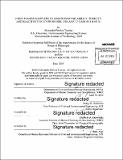| dc.contributor.advisor | Philip M. Gschwend. | en_US |
| dc.contributor.author | Tcaciuc, Alexandra Patricia | en_US |
| dc.contributor.other | Woods Hole Oceanographic Institution. | en_US |
| dc.date.accessioned | 2015-10-30T19:00:12Z | |
| dc.date.available | 2015-10-30T19:00:12Z | |
| dc.date.issued | 2015 | en_US |
| dc.identifier.uri | http://hdl.handle.net/1721.1/99608 | |
| dc.description | Thesis: Ph. D., Joint Program in Marine Chemistry and Geochemistry (Massachusetts Institute of Technology, Department of Civil and Environmental Engineering; and the Woods Hole Oceanographic Institution), 2015. | en_US |
| dc.description | Cataloged from PDF version of thesis. | en_US |
| dc.description | Includes bibliographical references. | en_US |
| dc.description.abstract | Hydrophobic organic chemicals (HOCs) are a class of environmental contaminants responsible for numerous acute and chronic health effects in humans and wildlife. This thesis illustrates three applications of polyethylene (PE) passive sampling, which enhance our toolbox for estimating environmental hazards associated with HOCs. First, we present a methodology that can be used to estimate the bioaccumulation potential of numerous organic chemicals based on passive sampling and comprehensive two dimensional gas chromatography (GC x GC). Using GC x GC retention times, we show that lipid-water and samplerwater partition coefficients can be estimated within a factor of 2 and 3, respectively. The method was then applied to estimate body burdens of various HOCs in benthic organisms from GC x GC analysis of PE equilibrated with contaminated sediment. Empirical observations of accumulation in the Nereis virens polychaete were in good agreement with PE-based predictions for PCBs, but were lower by at least an order of magnitude for other classes of HOCs (such as PAHs) presumably due to metabolism. Second, we applied the same methodology to a set of contaminated sediments and estimated the cumulative baseline toxicity associated with environmental mixtures of HOCs. The predictions were compared against empirical measurements of baseline toxicity using the water flea Daphnia magna. The estimated total body burdens of HOCs were in good agreement with measured toxicity, with toxicity occurring at body burdens larger than 30 mg/gipid. In contrast, the toxicity estimated based on priority pollutants severely underestimated the observed toxicity, emphasizing the importance of cumulative effects. Lastly, to advance our understanding of the processes that affect passive sampling results in situ (when they are operating away from equilibrium), a mathematical model was developed for reactive chemicals transferring between PE and sediment beds. The reaction diffusion model was used to infer in situ degradation rates of dichlorodiphenyltrichloroethane (DDT), which in the sediments of a freshwater lake were found to be between 0.09 and 0.9 d-1. A second mathematical model describing the kinetics of exchange between passive samplers and water was also developed, which can be used in both field (infinite baths) and laboratory (finite baths) conditions. | en_US |
| dc.description.statementofresponsibility | by Alexandra Patricia Tcaciuc. | en_US |
| dc.format.extent | 269 pages | en_US |
| dc.language.iso | eng | en_US |
| dc.publisher | Massachusetts Institute of Technology | en_US |
| dc.rights | M.I.T. theses are protected by copyright. They may be viewed from this source for any purpose, but reproduction or distribution in any format is prohibited without written permission. See provided URL for inquiries about permission. | en_US |
| dc.rights.uri | http://dspace.mit.edu/handle/1721.1/7582 | en_US |
| dc.subject | Joint Program in Marine Chemistry and Geochemistry. | en_US |
| dc.subject | Civil and Environmental Engineering. | en_US |
| dc.subject | Woods Hole Oceanographic Institution. | en_US |
| dc.subject.lcsh | Marine pollution | en_US |
| dc.subject.lcsh | Chemical oceanography | en_US |
| dc.title | Using passive samplers to assess bioavailability, toxicity, and reactivity of hydrophobic organic chemicals (HOCs) | en_US |
| dc.type | Thesis | en_US |
| dc.description.degree | Ph. D. | en_US |
| dc.contributor.department | Joint Program in Marine Chemistry and Geochemistry | en_US |
| dc.contributor.department | Woods Hole Oceanographic Institution | en_US |
| dc.contributor.department | Massachusetts Institute of Technology. Department of Civil and Environmental Engineering | |
| dc.identifier.oclc | 925528675 | en_US |
